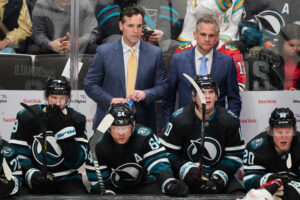As the Edmonton Oilers losing streak stretched to a whopping six games following a 5-1 drubbing by the Toronto Maple Leafs, few words sprung to mind. One word that did, and actually has lingered for quite some time, is fragile. The same old fragile Edmonton Oilers.
Make no mistake about it, despite the progress that this team has shown over the past two years under the Ken Holland regime, one theme has started to become a problematic pattern. It’s that when the going gets tough, this group of fragile Oilers shut down.
A History of Fragility for the Edmonton Oilers
When Edmonton welcomed the Chicago Blackhawks into an empty Rogers Place for the 2020 bubble playoffs, it almost seemed too easy that the fifth-ranked Oilers would dismantle the 12th ranked Blackhawks. That didn’t happen. After a Game 1 dismantling by Chicago, the Oilers looked outmatched, uninspired, and again, fragile. They could only muster a single win in that five-game series before being eliminated before the real fun even began.
Fast forward a year and the Oilers enter the playoffs once more following a rather strong regular season. Like the year prior, fragility follows. The Winnipeg Jets gave them a 4-1 punch in the face in Game 1, and the Oilers responded with three more losses. They were out of the playoffs as quickly as they had entered them, without even a single push back.
That series against the Jets has many parallels to this recent six-game slump. In that Jets’ series, the Oilers suddenly couldn’t score, their power play wasn’t quite as hot, their goaltending was lesser than their opponent’s, and although in the majority of those games the Oilers “looked” like the better team on paper, they still lost.
Recent Fragility
In last week’s game against the Boston Bruins, the Oilers found themselves down 2-0. Remarkably, they clawed back and tied the game in the third period. It seemed as though the tide was set to turn. That didn’t happen. Almost immediately following the tying goal, Boston picked up their play, and the Oilers happily obliged. With only a couple of minutes remaining, the Oilers stumbled, scrambled, and conceded Boston’s lead right back to them.
Matt Grzelcyk gives the Bruins the lead.
3-2 Boston with 2:33 left in regulation. pic.twitter.com/AAuAYzWAI6
— Conor Ryan (@ConorRyan_93) December 10, 2021
That was a game where the Oilers “looked” like the better team. They weren’t. When it mattered the most, they spit the bit.
Why is that? Why is it that in real times of adversity, such as the two previous playoffs, the injury bug that hit the defence this season, and the ensuing losing streak, this team tends to turn into the same old fragile Oilers?
That’s a question that general manager Ken Holland needs to figure out and in a hurry.
Fragile Leadership
Is it the leadership? That’s quite a leap to make, especially considering that both Connor McDavid and Leon Draisaitl have 45 points in 27 games this season. Offensively they are certainly leading the team. However, what level of responsibility should they take for inspiring the play of others? Should they take any?
It does make you scratch your head and wonder how a team like the Pittsburgh Penguins, which has had more significant injuries this season, plus a tougher battle with covid, has found a way to weather the storm without such a dramatic low-point in the process.
That’s a team that seems to endure and overcome significant hurdles in a way that this Oilers team just hasn’t figured out quite yet.
Has the loss of Mike Smith on the ice contributed to some of this fragility, with the lack of his temper and flare a legitimate detriment? Maybe, but Smith was in both of those playoff series in years prior, and these issues were still present.
Plus, the team brought in veterans such as Zach Hyman, Duncan Keith, and Cody Ceci, in addition to internally developed leaders like Darnell Nurse and Ryan Nugent-Hopkins. This team is not short on “leaders”, from a games-played/personality perspective at least.
Fragile Depth
Maybe the issue isn’t so much the lack of leadership in a traditional sense, but more so a lack of depth players who can lead with their play on the ice.
A quick trip to Natural Stat Trick tells us the obvious when it comes to Edmonton’s depth. It’s just not good enough.
Sorting the Oilers by five on five statistics, we see a few names at the bottom of the list who most certainly match the eye test in terms of disappointing play:
- Zack Kassian
- Tyson Barrie
- Ryan Nugent-Hopkins
- Kailer Yamamoto
- Kyle Turris
- Brendan Perlini
- Devin Shore
- Kris Russell
- Derek Ryan
Every single one of these players is below 50% in most, if not all of Corsi, Fenwick, Expected Goals, and Scoring Chances.
It’s actually quicker to count the names who are mostly above 50% in these metrics: Connor McDavid, Nurse, Jesse Puljujarvi, Hyman, and Evan Bouchard.
Ceci, Keith, and Warren Foegele find themselves somewhere in the middle, but more so on the positive side of the ledger.
Lineup Imbalance
That is quite a significant imbalance that has exploded into cant-ignore territory over the past two weeks. Two-thirds of the roster is actively bleeding out chances and possession at a rapid rate. Only six or seven individuals are performing up to the task.
It’s hard to be a true leader and inspire change when your time on the ice is spent getting caved in.
Would this team be better off with a Ryan Getzlaf type as the third-line centre? A Kevin Fiala in the bottom six? An Adam Larsson type still on the blue line?
On paper, absolutely. This, however, ignores one of the more fundamental, long-term issues of this team that no amount of blue sky, idealistic player dreaming and scheming will solve.
Fragile Coaching
There’s been a pattern of players being unable to excel in Edmonton, but moving on to find success, even in a lesser role, elsewhere.
Milan Lucic, Cam Talbot, Andrej Sekera, and Justin Schultz are just a few of the more recent examples. Even Andreas Athanasiou, who the Oilers gave up two second-round picks to acquire two seasons ago, has suddenly emerged as a positive contributor on the Los Angeles Kings.
Why do players who struggle in Edmonton, so often find a successful role elsewhere? Is it their deployment? Does Dave Tippett struggle from the same issue that Todd McLellan had, which was an inability to maximize a lineup around Edmonton’s two stars?
The issues certainly look the same.
Under Tippett, there’s still an over-reliance to lean on the McDavid/Draisaitl duo to produce almost all of the team’s scoring. The team also rarely comes prepared to start games, an issue that lead to goals on the first shot of the game against Talbot, and now routinely against Mikko Koskinen.
Lastly, under-performing veterans are given an exaggerated amount of opportunities (Kassian, Barrie), which has to be internally observed as a bit of a double standard.
Tippett has indeed found a way to take this team to the postseason in consecutive seasons, yet a series win still remains far out of grasp. This leaves little confidence that long-term issues will be solved any time soon under this coaching regime.
Cycle of Fragility
Well then, what’s the key issue? Why is the group repeatedly the same old fragile Oilers?
When you spell it all out, it’s a vicious cycle, with several contributing factors. Real adversity produces cold streaks from the Oilers’ stars, which is exaggerated by what seems to be poor coaching tactics, which produces anemic scoring depth, which leads to a more selfish brand of do-it-yourself hockey, that ultimately leaves little structure in their game, resulting in meaningful losses.
This cycle can last a short as a four-game playoff series, or as long as this current slump will extend.
If this cycle of fragility is to be broken in a meaningful way, change must occur. The most pressing issue has to be how anyone outside of this team’s top five or so players consistently finds such little success here but rapidly finds it elsewhere.
That seems to suggest coaching. which could leave Tippett’s seat the hottest of all.






